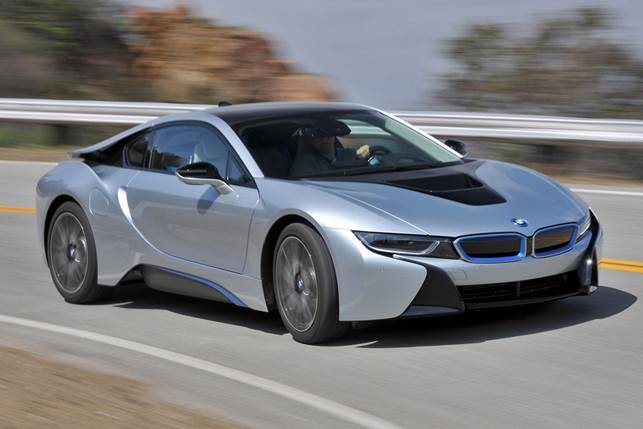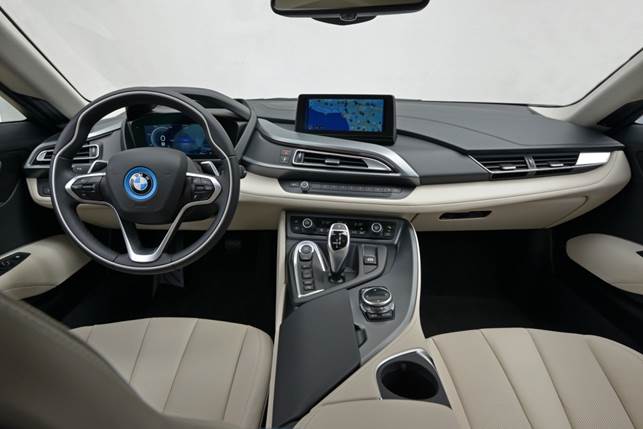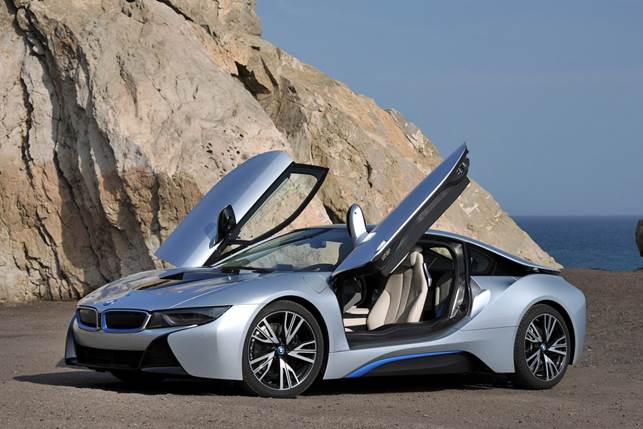Electric and hybrid cars designed for city
use are now becoming more affordable. Unless you’re seriously wealthy, hybrid
performance motoring remains the preserve of near-million pound cars from
Porsche, Ferrari and McLaren. Fresh from launching its i3 small car, BMW hopes
to change that with a dramatically styled plug-in petrol-electric coupé with an
asking price just under the magic six-figure mark, though a little dalliance
with the optional extras list, including the Pure Impulse design package, will
send the price soaring above. BMW never claimed that a carbon composite
two-door coupé powered by a high-tech three-cylinder 1.5-litre turbo petrol
engine and electric motor would be cheap, but the i8 just manages to remain a
sensible option if your other choice of car was Porsche’s 911.

The
i8 is the first sports car in which you can have your cake and eat it, offering
economy blended with masses of dynamic ability and excellent looks
The i8 is certainly rapid, and the ability
to mix and match power sources on the fly, be that automatically or manually,
ensures the ability to make indecent progress. Rear-wheel drive in petrol mode
and front drive when in electric mode, the elastic delivery of both power units
working together allows for rapid cruising and the crushing, point-to-point
grip and pace 911 Turbo owners will be familiar with. And so it should be with
a combined 357bhp, although the i8 defaults to electric power on start up for
relaxed, hushed motoring. Ideal for cities, you can also manage the battery
reserve so that it’s topped up on the move during a brisk run for your return
to the urban sprawl. In that mode you get 20-odd miles of electric-only
running.

The
cabin is a mixture of traditional BMW fare and more distinctive, individual
design
For all the i8’s on-road supercar-baiting
potential, it’s also being pitched as a functional machine. The plug-in hybrid
format should see a more time-friendly charging cycle of only a few hours, not
the overnight hassle of a pure electric car. The i8’s cabin is familiar high
quality BMW territory, although with a funky i3-styled twist to the look.
There’s a good level of standard kit, with LED headlights, gullwing doors and
20-inch alloy wheels taking care of the looks department, with satellite
navigation, an 8.8-inch screen, a range of connectivity options and DAB digital
radio looking after the technologically minded, with parking sensors and
head-up display fitted, too.

Like
the headlights, the intricately designed rear light clusters also feature the
characteristic BMW i U-shaped design
And while there are two rear seats, it’s
realistically a two-seater. Just as well considering the car’s high sills and
low seating position. Cabin access and egress predictably isn’t smooth – think
Lotus Exige. With the i8’s bonnet sealed shut, Audi A2-style, storage space is
modest; there’s those rear ‘seats’ and the small but deep boot aft of the
rear-mounted petrol engine, but rather predictably it’s a warm environment, so
don’t leave the shopping in there too long.

The
scissor-type doors that open forward and upward in wing-like fashion, add extra
intrigue to the design
It’s no surprise that, in practical terms,
the i8 is a little compromised. Its concept car looks are something of a
giveaway. However, it’s a talented and rewarding car to drive fast or slow. And
while at this price you don’t buy an i8 to save on your fuel bill, the car’s
potential is impressive. Sub 50g/km CO2 emissions and triple digit economy
ratings can’t be ignored, along with the London congestion charge exempt
status. The latter will no doubt appeal to high net worth city-based workers
that like to show off, as will the car’s modest company car benefit in kind
taxation figure. Could the i8 be the green supercar for environmentally
conscious industrialists?